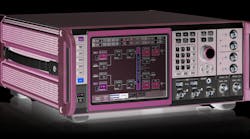Generating complex RF signals traditionally involves vector signal generators (VSGs) with in-phase quadrature (I/Q) modulators and analog synthesizers. However, an alternative approach takes advantage of high-speed digital-to-analog converters (DACs), enabling complex signals to be directly generated at microwave frequencies. In the white paper “Overcoming RF Signal Generation Challenges with New DAC Technologies,” Tektronix discusses the technology behind direct RF complex signal generation. Furthermore, a technique is presented that can be utilized to expand the frequency range of generated signals.
The white paper first explains that the common method of generating complex RF signals basically involves modulating a carrier signal. Essentially, a local-oscillator (LO) generates this carrier signal, which is modulated by a vector modulator. To illustrate this signal generation process, a simple block diagram is presented that shows an arbitrary waveform generator (AWG) supplying I/Q signals to a VSG.
The white paper points out that the traditional method of complex RF signal generation has the disadvantage of degraded signal modulation quality due to I/Q amplitude and phase imbalance and LO leakage. These pitfalls, which can be compensated for to some extent, are due to hardware non-idealities of the vector modulator. Another disadvantage is the increased cost and complexity for large-scale, multi-channel RF systems.
Modern DACs can integrate more functionality into a single chip, with some advanced versions incorporating features like finite-impulse-response (FIR) filters, digital interpolation, complex modulation, and numerically-controlled oscillators (NCOs). As a result, complex RF signals can be directly generated in an efficient and compact manner. A simplified block diagram of the high-speed, 16-bit DAC used in Tektronix’s AWG5200 Series of AWGs is shown. The functionality of this DAC is explained in detail.
The white paper analyzes the frequency response of a DAC in mathematical terms. The magnitude of the complex output spectrum of a DAC generating an arbitrary waveform is illustrated. Examples of direct RF signal generation using the AWG5200 Series are described. The document also explains how the frequency range can be extended by implementing a superheterodyne upconversion method.
Tektronix Inc., 14150 SW Karl Braun Dr., Beaverton, OR, 97077; (800) 833-9200

